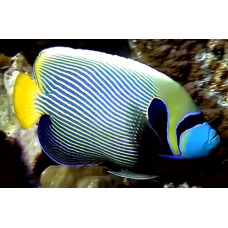Latin name
Pomacanthus imperator
Other names
Pomacanthus imperator
Identification
It has an oval body, slightly elongated, strongly compressed at the sides. The mouth is elongated, ending in a beak-like shape. The eyes are slightly rolled out.
Features of fish fins
The dorsal and anal fins are long and end near the tail peduncle. The edges of these fins are rounded. Dorsal spines: 13-14; Anal spines: 3. The dorsal fin has 13-14 hard and 17-21 soft rays, the anal fin has 3 hard and 18-21 soft rays.
Fish colouring
Coloration of the sides is blue or blue with closely spaced narrow horizontal and diagonal yellow stripes entering the dorsal and anal fins, anterior part of the head is white, an arc-shaped black with purple tint and blue edges stripe passes through the eyes, the same color vertically elongated spot is located above the pectoral fins. The anterior part of the back is green, the upper edge of the dorsal and caudal fins is yellow-orange, the pelvic and anal fins are blue with longitudinal brown stripes. Juveniles are blue-black with concentric white and blue circles. It acquires adult colouration when it reaches a length of 8-12 cm.
Distribution
Occurs in the tropical waters of the Indian and Pacific Oceans from the Red Sea and the coast of East Africa to the Hawaiian Archipelago, the Tuamotu and Kiribati Islands, northwards to southern Japan and the Bonin Islands, southwards to the Great Barrier Reef, New Caledonia and the southern islands of French Polynesia. It is not found near the Marquesas Islands or Easter Island. Geographically, the Imperial Angel's range is between 31°N and 28°S, 32°E and 144°W. The Indian and Pacific Ocean populations may be separate species.
Habitat
Inhabits inner and outer slopes of coral reefs and deep lagoons, found at depths from 1 to 100 m. Bottom fish. Usually seen around ledges and caves. Juveniles are found mainly under ledges and in burrows in shallow reef waters.
Size
Body length up to 40 cm. Average weight: up to 1 - 1.3 kg (2.2 - 2.9 lb).
Behavior
A non-migratory species. Protects its fairly large territory from similarly sized fish of its own or other species.
Food and feeding habits
Feeds mainly on sponges, crustaceans and other benthic invertebrates.
Reproduction
Protogynous hermaphrodites. During the breeding season, the male mates with several females in its territory. Courtship and mating take place at dusk. Eggs and larvae are pelagic. Eggs are round, 0.6-1 mm in diameter. Larvae emerge 1.3-2.6 mm long, with a large yolk sac, an unformed mouth and unpigmented eyes. As they grow, their bodies become larger and more compressed at the sides. Life expectancy is up to 14 years.
Fishing
They are often caught in the wild and exported to international markets, causing their already low population densities to decline.
Relationship with a person
A popular marine aquarium species.
| Classification | |
| Phylum | Chordata |
| Class | Actinopterygii |
| Squad | Perciformes |
| Family | Pomacanthidae |
| Genus | Pomacanthus |
| Species | P. imperator |
| Features | |
| Conservation status | Least Concern |
| Habitat | Bottom |
| Life span, years | 14 |
| Maximum body weight, kg | 1,3 |
| Maximum length, cm | 40 |
| Sailing speed, m/s | No information |
| Threat to people | Not edible |
| Way of eating | Planktonophage |
Emperor angelfish
Tags: emperor angelfish



